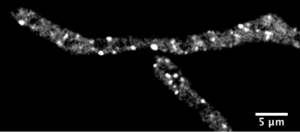Relevance
For the Public: How does this research relate to the problems of the world?
Why do we study fungi and large cells?
Shown is a single fungal cell growing under the microscope.
The white spots are individual nuclei, where the genome is located.
We study cells with many nuclei (the compartment that houses the genome) because they face special challenges in growth and division due to their size and lifestyles. These specialized cells are common in the natural world and include many pathogenic fungi, our bones, blood, cancer cells and the mammalian placenta. Fungi threaten food supplies and crops, are responsible for large-scale amphibian deaths across the planet and are responsible for infections in immunocompromised humans. We are interested in fungi in the marine environment not only to find new biological problems but because they may be relevant for cycles of plankton growth and decomposition that is important for carbon cycling. Our work on the cell biology of large cells with many nuclei like fungi, muscle and placenta helps us understand the normal behavior of these kinds of cells so that we can be better informed to solve the problems that arise from abnormal function in these cells.
How does this work relate to neurodegenerative disease, aging and pregnancy disorders?

condensed in the cytoplasm.
One unexpected discovery from our work on large cells with many nuclei is that protein sequences that have traditionally been associated with pathologies like neurodegenerative disease have a normal function to create special compartments within the cytoplasm of cells. Our work combined with many other labs has shown that the same physical processes that lead to pathological aggregates in cells are actually being used for normal cell physiology. Macromolecules in cells can exists in different states such as gas, liquid, or solid just like water. As cells are stressed, age or are exposed to certain environmental conditions, the molecules move from a more liquid-state to a more solid state. Understanding how cells can prevent this transition is important in understanding how these diseases progress.